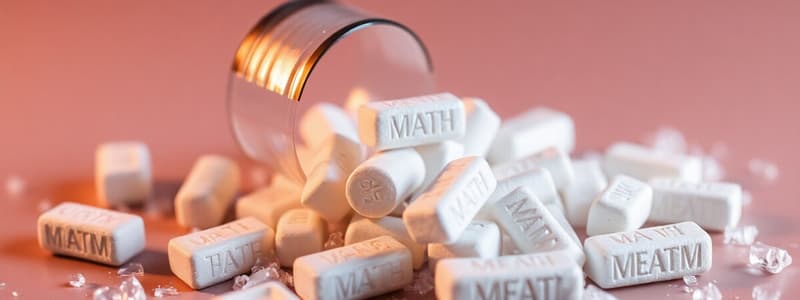Podcast
Questions and Answers
What is a primary medical use of amphetamines?
What is a primary medical use of amphetamines?
- To treat Alzheimer's disease
- To enhance cognitive abilities in healthy adults
- To alleviate chronic pain conditions
- To manage attention deficit hyperactivity disorder (ADHD) (correct)
Which form of methamphetamine is known to be the most potent and addictive?
Which form of methamphetamine is known to be the most potent and addictive?
- Liquid methamphetamine
- Crystal methamphetamine (ice) (correct)
- Powdered methamphetamine
- Methamphetamine pills
What is the typical duration to feel the effects of ice when smoked?
What is the typical duration to feel the effects of ice when smoked?
- 15 to 20 minutes
- 3 to 5 minutes
- 30 to 60 minutes
- Immediately (correct)
Why is crystal methamphetamine classified as a Schedule II substance?
Why is crystal methamphetamine classified as a Schedule II substance?
What effects does the higher purity level of ice have compared to lower purity levels?
What effects does the higher purity level of ice have compared to lower purity levels?
Which route of administration is characterized by the quickest onset of effects for ice?
Which route of administration is characterized by the quickest onset of effects for ice?
What common feature is shared by both crystal methamphetamine and powdered methamphetamine?
What common feature is shared by both crystal methamphetamine and powdered methamphetamine?
How is ice commonly described in terms of its appearance?
How is ice commonly described in terms of its appearance?
What is one recommended treatment for methamphetamine overdose that helps manage hyperthermia?
What is one recommended treatment for methamphetamine overdose that helps manage hyperthermia?
Which symptom is commonly experienced during the come-down period from methamphetamine use?
Which symptom is commonly experienced during the come-down period from methamphetamine use?
What common physical finding may indicate methamphetamine abuse during an autopsy?
What common physical finding may indicate methamphetamine abuse during an autopsy?
Which of the following conditions can arise from chronic methamphetamine use related to heart health?
Which of the following conditions can arise from chronic methamphetamine use related to heart health?
Which of the following agents is used as an adjunct treatment for symptoms associated with methamphetamine use?
Which of the following agents is used as an adjunct treatment for symptoms associated with methamphetamine use?
What is a possible consequence of using depressant drugs during methamphetamine come-down?
What is a possible consequence of using depressant drugs during methamphetamine come-down?
During a methamphetamine-induced hallucination, users may report feeling what sensation?
During a methamphetamine-induced hallucination, users may report feeling what sensation?
What type of medical intervention is indicated for seizures caused by methamphetamine use?
What type of medical intervention is indicated for seizures caused by methamphetamine use?
Which of the following long-term effects is NOT commonly associated with methamphetamine use?
Which of the following long-term effects is NOT commonly associated with methamphetamine use?
What mechanism is NOT involved in the action of indirect agonists for neurotransmitters?
What mechanism is NOT involved in the action of indirect agonists for neurotransmitters?
Which symptom is NOT typically observed during a methamphetamine overdose?
Which symptom is NOT typically observed during a methamphetamine overdose?
Which behavioral symptom is most closely associated with methamphetamine use?
Which behavioral symptom is most closely associated with methamphetamine use?
In methamphetamine use, which physical symptom is least likely to manifest?
In methamphetamine use, which physical symptom is least likely to manifest?
What psychological symptom is NOT typically noted in methamphetamine users?
What psychological symptom is NOT typically noted in methamphetamine users?
Which complication is most directly associated with injecting methamphetamine?
Which complication is most directly associated with injecting methamphetamine?
Which of the following is not a recommended immediate treatment for methamphetamine overdose?
Which of the following is not a recommended immediate treatment for methamphetamine overdose?
Flashcards
What are amphetamines?
What are amphetamines?
Amphetamines are a class of drugs that stimulate the central nervous system. They speed up messages between the brain and body.
What is 'ice'?
What is 'ice'?
Crystal methamphetamine, also known as 'ice', is a highly potent, addictive stimulant that comes in crystal or powdered form. It's known for its intense and long-lasting effects.
Why is crystal methamphetamine illegal?
Why is crystal methamphetamine illegal?
Crystal methamphetamine is a Schedule II substance, meaning it has a high potential for abuse and dependence. It is illegal to manufacture, possess, or distribute without a prescription.
How is 'ice' used?
How is 'ice' used?
Signup and view all the flashcards
What are the effects of crystal methamphetamine?
What are the effects of crystal methamphetamine?
Signup and view all the flashcards
What are the dangers of crystal methamphetamine?
What are the dangers of crystal methamphetamine?
Signup and view all the flashcards
Is there a difference between prescribed amphetamines and 'ice'?
Is there a difference between prescribed amphetamines and 'ice'?
Signup and view all the flashcards
What are the main takeaways about crystal methamphetamine?
What are the main takeaways about crystal methamphetamine?
Signup and view all the flashcards
Methamphetamine
Methamphetamine
Signup and view all the flashcards
Indirect Agonist for Neurotransmitters
Indirect Agonist for Neurotransmitters
Signup and view all the flashcards
Methamphetamine Psychosis
Methamphetamine Psychosis
Signup and view all the flashcards
Methamphetamine Dependence
Methamphetamine Dependence
Signup and view all the flashcards
Physical Symptoms of Methamphetamine Use
Physical Symptoms of Methamphetamine Use
Signup and view all the flashcards
Mood Symptoms of Methamphetamine Use
Mood Symptoms of Methamphetamine Use
Signup and view all the flashcards
Behavioral Symptoms of Methamphetamine Use
Behavioral Symptoms of Methamphetamine Use
Signup and view all the flashcards
Methamphetamine Overdose
Methamphetamine Overdose
Signup and view all the flashcards
Methamphetamine-induced Paranoia
Methamphetamine-induced Paranoia
Signup and view all the flashcards
Gastric Lavage
Gastric Lavage
Signup and view all the flashcards
Crystalloid
Crystalloid
Signup and view all the flashcards
Crank Bugs
Crank Bugs
Signup and view all the flashcards
Meth Mouth
Meth Mouth
Signup and view all the flashcards
Come-Down
Come-Down
Signup and view all the flashcards
Dopamine
Dopamine
Signup and view all the flashcards
Binge & Crash Cycle
Binge & Crash Cycle
Signup and view all the flashcards
Study Notes
Amphetamines
- Amphetamines are psycho-stimulant drugs that speed up messages between the brain and the body.
- Some amphetamines are prescribed to treat conditions like ADHD and narcolepsy.
- Others, like speed, are produced and sold illegally.
- Crystal methamphetamine (ice) is a potent form.
What is Ice?
- Crystal methamphetamine (ice) is a colorless, odorless stimulant.
- It's stronger and more addictive than powdered methamphetamine (speed).
- It comes as small, chunky crystals, sometimes looking like ice or fragments of glass, or as a white or brownish crystal-like powder.
- Ice has a strong smell and a bitter taste.
- Other names for ice include crystal meth, shabu, crystal, glass, and shard.
Methods of Use
- Ice can be smoked, injected, snorted, or swallowed.
- Smoked ice produces an almost immediate effect.
- Injected ice takes 15-30 seconds to take effect.
- Swallowed ice takes 15-20 minutes to take effect.
- Snorting ice produces an effect in 3-5 minutes.
- Purity level affects duration and intensity of effects.
Why is Ice Illegal?
- Crystal methamphetamine is a Schedule II substance under the Controlled Substances Act.
- Schedule II substances, like cocaine and PCP, have a high potential for abuse.
- Abuse of these drugs can cause severe psychological or physical dependence.
How Ice Affects the Body
- Indirect agonist for dopamine, noradrenaline, and serotonin (5-HT).
- Mechanism: Blocks monoamine reuptake, inhibits MAO metabolism, and inhibits vesicular storage, and reverse reuptake.
Effects of Ice on Organs
- Neurologic: Delirium, tremors, choreiform movements, intracranial hemorrhage.
- Psych: Anxiety, paranoia, hallucinations, delusions, suicidal or homicidal behavior, compulsive behavior (skin picking/formication, hair pulling).
- ENT: Dry mouth (xerostomia), teeth grinding (bruxism), poor oral hygiene, nasal injuries.
- Cardiovascular: Tachycardia, hypertension, dysrhythmias, myocardial infarction, dilated cardiomyopathy.
- Pulmonary: Pulmonary hypertension, acute respiratory distress syndrome (ARDS).
- Gastrointestinal: Nausea, vomiting, diarrhea, ischemic colitis.
- Renal: Acute kidney injury, rhabdomyolysis.
- Musculoskeletal: Rigidity, rhabdomyolysis.
- Skin: Diaphoresis, soft tissue infections (abscesses).
Long-Term Effects
- Anxiety, confusion, sleep problems
- Hallucinations, delusions
- Methamphetamine psychosis, Psychotic behavior
- Chronic depression
- Severe weight loss
- Brain damage
Clinical Presentation
- Symptoms include hyperthermia, euphoria, dilated pupils, sweating, insomnia, tachycardia, arrhythmia, decreased appetite ,increased alertness and energy.
Mood Symptoms
- Anxiety, restlessness, panic
- Aggression
- Racing thoughts, severe depression following binges, violent mood swings, delusions of grandeur.
Behavioral Symptoms
- Risky sexual behavior
- Avoidance of hobbies and pleasurable activities
- Borrowing/stealing money
- Preoccupation with the next high
- Pulling away from friends/family
- Engaging in unsafe activities.
Physical Symptoms
- Marked weight loss, cardiac arrhythmias, malnutrition, respiratory problems
- Acne, picking scars, loss of skin elasticity, "meth mouth"
- Brain damage, seizures
Psychological Symptoms
- Confusion, memory loss
- Disorganized lifestyle
- Paranoia
- Psychosis, hallucinations
- Total break from reality.
Other Health Risks
- Injecting ice increases risk of tetanus, infection, and vein damage.
- Sharing needles increases risk of hepatitis B & C, and HIV/AIDS.
- Snorting ice can cause nasal passage damage and nosebleeds.
Overdose
- Symptoms include chest pain, breathing problems, fits, agitation, confusion, clumsiness, headache, unconsciousness, stroke, heart attack.
Treatment
- Physical/chemical restraints can be used to prevent harm.
- Aim to treat life-threatening symptoms (compromised airway, seizures, tachycardia, hyperthermia).
- Gastric lavage with antidotes, activated charcoal, intravenous fluids to eliminate the drug.
- Intravenous phentolamine, nitroprusside or nitroglycerin for end-organ failure
- Supportive care like antibiotics for infections, sedation (diazepam, chlorpromazine).
Coming Down
- Recovery can take days, potential effects include difficulty sleeping, exhaustion, headaches, dizziness, blurred vision, paranoia, hallucinations, confusion, and irritability.
Addiction Cycle
- Use of depressant drugs (alcohol, benzodiazepines, cannabis) to manage come-down effects can lead to dependence on both types of drugs.
Autopsy Findings
- Recent needle marks (cubital fossa, arms, ankles, groin, neck).
- "Crank Bugs" (itching, scratching).
- Extreme weight loss, prominent bones and ribs.
- "Meth Mouth" (severe tooth decay/damage)
Additional Notes
- Pathological changes in the heart (cardiac arrhythmias, myocardial fibrosis, coronary artery fibrosis).
- Systemic infections (Hepatitis B/C)
- Severe burns.
- The drug boosts dopamine release leading to intense elevated mood and increased addictive behavior.
Studying That Suits You
Use AI to generate personalized quizzes and flashcards to suit your learning preferences.




